Related Research Articles
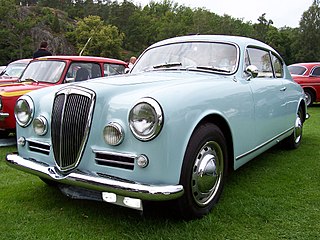
A grand tourer (GT) is a type of car that is designed for high speed and long-distance driving due to a combination of performance and luxury attributes. The most common format is a front-engine, rear-wheel-drive two-door coupé with either a two-seat or a 2+2 arrangement. Grand tourers are most often the coupé derivative of luxury saloons or sedans. Many iconic car models, such as the Ferrari 250 GT, Jaguar E-Type, and Aston Martin DB5, are considered classic examples of gran turismo cars.

Alfa Romeo Giulia is the name of three not directly related models by the Italian car manufacturer Alfa Romeo. The first is a line of sporty four-door compact executive cars produced from 1962 to 1978, the second is an updated, mainly up-engined Spider, Sprint and Sprint Speciale Giuliettas, and the third Giulia is a compact executive car unveiled in 2015.

The Alfa Romeo Alfasud Sprint is a boxer-engined coupé produced by the Italian manufacturer Alfa Romeo from 1976 to 1989, and based on the Alfa Romeo Alfasud. 116,552 units of the Alfasud Sprint and Sprint were built in total. The Sprint was sold in Europe, South Africa, Australia, and New Zealand.

The Alfa Romeo Montreal is a 2+2 coupé sports car produced by the Italian manufacturer Alfa Romeo from 1970 to 1977.

The Alfa Romeo GTA is a coupé automobile manufactured by the Italian manufacturer Alfa Romeo from 1965 to 1971. It was made for racing (Corsa) and road use (Stradale).

The Alfa Romeo Alfetta is a front-engine, five-passenger sedan and fastback coupé manufactured and marketed by Alfa Romeo from 1972 to 1987 with a production total over 400,000.

The Alfa Romeo Twin Cam engine is an all-alloy inline-four engine series produced by Alfa Romeo from 1954 to 1994. In Italian it is known as the "bialbero" ("twin-shaft"), and has also been nicknamed the "Nord" (North) engine in reference to its being built in Portello, Milan, in the North of Italy and to distinguish it from the Alfa Romeo Boxer engine built in the South (Sud) for the Alfasud.
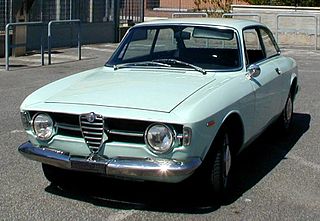
The Alfa Romeo 105 and 115 series coupés are a range of cars made by the Italian manufacturer Alfa Romeo from 1963 until 1977, based on a shortened floorpan from the Giulia saloon. They were the successors to the Giulietta Sprint coupé.

The Alfa Romeo V6 engine is a 60° V6 engine made by Alfa Romeo from 1979 to 2005. It was developed in the early 1970s by Giuseppe Busso, and first used on the Alfa 6 with a displacement of 2.5 L (2,492 cc) and a SOHC 12-valve cylinder head. Later versions ranged from 1,996 to 3,179 cc and had DOHC 24-valve valvetrains. The original design had short pushrods for the exhaust valves in a design similar to earlier Lancia Fulvia engines. The first DOHC version was in the 1993 Alfa Romeo 164, with an aluminium alloy engine block and head with sodium filled exhaust valves.

During its history, Alfa Romeo has competed successfully in many different categories of motorsport, including Grand Prix motor racing, Formula One, sportscar racing, touring car racing and rallies. They have competed both as a constructor and an engine supplier, via works entries and private entries. The first racing car was made in 1913, three years after the foundation of A.L.F.A., the 40/60 HP had 6-litre straight-4 engine. Alfa Romeo quickly gained a good name in motorsport and gave a sporty image to the whole marque.
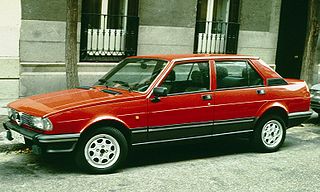
The Alfa Romeo Giulietta is a small executive saloon car manufactured by Italian car maker Alfa Romeo from 1977 to 1985. The car was introduced in November 1977 and while it took its name from the original Giulietta of 1954 to 1965, it was a new design based on the Alfa Romeo Alfetta chassis. The Giulietta went through two facelifts, the first in 1981 and the second one in 1983. All Giuliettas used 5-speed manual transmissions.

Giuseppe Busso was an Italian mechanical and engine designer mostly known for his tenure at Alfa Romeo and Ferrari.
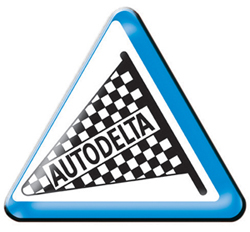
Autodelta SpA was the name of Alfa Romeo's competition department. Established in 1961 as Auto-Delta by Carlo Chiti and Lodovico Chizzola, former Alfa Romeo and Ferrari engineers, the company was officially made a department of Alfa Romeo on March 5, 1963 by the then president of Alfa Romeo Giuseppe Luraghi. Originally based in Feletto Umberto, Udine, the team subsequently moved closer to Alfa Romeo's facilities in Settimo Milanese in 1964, officially becoming Autodelta SpA. The move enabled Autodelta to use the Balocco test track for new racing cars and prototypes.

The Alfa Romeo Spider is a two-seater, front-engined, rear-drive roadster manufactured and marketed by Alfa Romeo from 1966 to 1994 in four distinct generations, or "series", each with modifications ranging from modest to extensive.
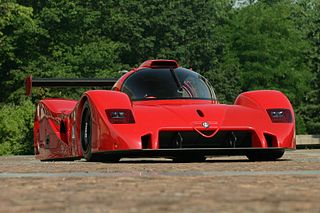
The Alfa Romeo SE 048SP was a Group C racing car built by Alfa Romeo in the early 1990s. Designed to replace the Lancia LC2 after the Group C regulations had undergone a major revamp, the SE 048SP had an Abarth-developed chassis mated to the 3.5-litre V10 engine from the stillborn Alfa Romeo 164 Procar, but, although at least one SE 048SP was built, it never left the development phase. The V10 engine appears to have been replaced by a Ferrari-sourced 3.5-litre V12 engine at some point during its development, although this was never officially confirmed by Alfa Romeo.

The Alfa Romeo Tipo 103 is a sub-compact front-wheel drive automobile developed by Alfa Romeo in the late 1950s. A prototype powered by a 0.9 L double overhead cam inline-four engine was completed in 1960. Alfa did not put the Tipo 103 into production.
The Alfa Romeo Eagle is a concept car built by Pininfarina. The car debuted at the Turin Auto Show in 1975.

The Alfa Romeo Iguana is a concept car produced by Alfa Romeo in 1969. It was designed by Giorgetto Giugiaro at Italdesign.

The Alfa Romeo Scarabeo is a concept car engineered by Giuseppe Busso and Orazio Satta Puliga for Alfa Romeo with a body designed by Sergio Sartorelli at Officine Stampaggi Industriali. The car debuted at the Paris Motor Show in 1966.
The history of Alfa Romeo, an Italian car manufacturer known for producing sports cars, began on June 24, 1910 with the founding of ALFA in Milan. In 1918 the company changed its name to "Alfa Romeo" following the acquisition of control of the company by Nicola Romeo.
References
- ↑ "Autodelta Italia". Autodelta Italia (in Italian). Retrieved 2018-06-17.[ dead link ]
- 1 2 3 Ardizio, Lorenzo (2015). Alfa Romeo All the Cars. Giorgio Nada Editore. pp. 288–289. ISBN 978-8879115902.
- ↑ Goldoni, Luca (1979). Alfa Romeo History Museum. Italy: Arese. pp. 108–114.